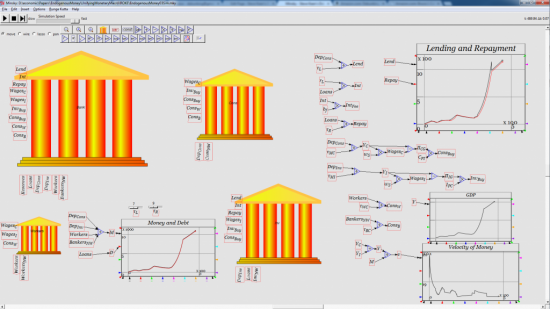To Minsky, or not? That it the question. From Richard Murphy's blog on Tax Justice etc.
As I mentioned yesterday, I spent six hours with Steve Keen yesterday. He cam down to see me in Ely, and we talked economics, MMT, annoying aspects of ageing and about his software programs, Minsky and Ravel.
Minsky is an economic modelling tool built on the principles of double entry. It is open source and free. There is a manual of a couple of hundred pages. Anyone is free to have a go, but as we rapidly found, it's best not to try it on a Mac, where it only ‘sort of' works.
The process begins by defining the key players in the model that is being built. We looked at the function of central banks and so looked at the central bank, private banks, the Treasury and the private sector economy (which was a bit of a catch all that could clearly be expanded).
Then you define the flows each might make e.g. government spending, taxes, bond issues, bond redemptions and repurchases, interest paid and so on, plus similar flows in the private sector e.g. loans and interest, etc.
The model has to balance: critically, you are not allowed to make single entries (or rather, you are, but the model will make clear that it does not work, so you have to put them right). Given that most government accounting is single entry and most macro does not really recognise the role of money in the economy, this is in itself quite revolutionary stuff.
Then Steve worked forward, explaining how relationships between variables can be defined within parameters so that behaviour can be predicted. You begin to end up with screens looking like this:

Charting results is one of the easier things to do.
I make no pretence that I have learned the programme as yet. There is syntax that I have been introduced to, but I suspect have not mastered as yet. And there were methods used that I am bound to forget until I try it for myself and have to rediscover them - although at least I know they are there, somewhere, now. That seems a little daunting, but so too did computer aided design (CAD) when I first tried to use it, and now I am pretty good with it and have little difficulty thinking of ways to sort out issues. I suspect Minsky will be like that.
I actually think the comparison between CAD and Minsky might be quite appropriate. Both provide toolboxes and a workspace. What you do thereafter is up to you. If you have nothing you want to design using CAD there is no point learning it. If you have nothing in the economy that you want to model the effort spent learning Minsky would also be a waste of time.
What might I model? I was sufficiently excited by this model to lose sleep over it last night, something I am not inclined to do very often. Thoughts on what to model included:
- The problem of accounting for government interest costs in a period of inflation - which involves no known double entry in the way that the ONS does it.
- Accounting for government debt itself, which again is based on rather dubious single entry accounting in the way that the ONS do it.
- Modelling tax revenues and multiplier effects within them. Linking this to GDP would also be good. Linking it to wheat makes up GDP might be even better.
- Modelling central bank digitise currencies and what that would demand that the government get its head around.
I am certain there is a great deal more.
Ravel is a digital data display program that lays over Minsky. It is not open source or free. It looks to be very powerful. For those familiar with it, Tableu looks to be what it approximates to. For me I can see massive uses for it. Steve is giving me a copy.
However, all this requires an investment in a decent PC, because this requires i7 processing power and decent graphic cards I think, plus good storage to read and write what look like they could become pretty big files. That's my question for the day. Do I fork out now and break more than 12 years working solely on the Mac?
I will let you know. But the temptation is very a strong. These programs will let me look at issues in new ways. And that is always exciting. And it is for precisely this type of investment that I accept donations on the blog.
( Blogger comment Though interesting to some degree it is no match to the kind of understanding of the economy as understood in Transfinancial Economics).
Some links to more about Minsky/Keen model for anyone interested
No comments:
Post a Comment